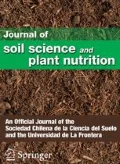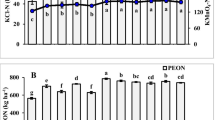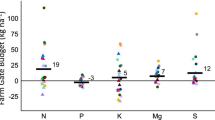Abstract
A dedicated soil testing method for estimating available nitrogen (N) in organic production system is currently lacking. In this backdrop, an innovative approach was initiated to develop a suitable method for assessing potentially mineralisable nitrogen (PMN) as N availability index in organically fertilised soils. To address the objective, a field experiment was conducted in an organically fertilised french bean crop after a 3-year crop cycle of aromatic rice-french bean-okra. Farmyard manure, vermicompost, mustard oil-cake, poultry manure and their different combinations equivalent to 120 kg N ha−1 were applied as sources of N. Chemically fertilised plots were also maintained as a check. PMN was derived using first-order kinetics, from the disappearance of organic-N at different growth stages of french bean using the methods involving 1/15 M phosphate buffer (PB), 0.01 M calcium chloride (CaCl2), 0.01 M sodium bi-carbonate (NaHCO3), and 0.1 M sodium hydroxide + 0.05 M ethylenediaminetetraacetic acid (Basic EDTA) extractants. The conventional alkaline permanganate method for N estimation was also used for comparison. PB derived significantly 22, 39 and 47% higher PMN than Basic EDTA, NaHCO3 and CaCl2 respectively. PMNs estimated by different methods were well correlated (r = 0.53** to 0.84**) among themselves while exhibited poor correlation with alkaline permanganate N (r = 0.30 to 0.41*). PB-derived PMN depicted the strongest linear relationship with pod yield (r = 0.89**, R2 = 0.80**) and N uptake (r = 0.81**, R2 = 0.66**). The reliability of PB as the most suitable method was further established by principal component analysis as PB explained the highest proportion (73%) of total PMN variation. Beyond its consequential quantitative evaluation, the ability of PB to extract organic-N compounds of similar chemical nature (uniform C:N ratio, 12–14) from diverse organic sources confirmed its superiority. Adopting PB to estimate PMN as an index of N availability will thus assist soil testing agencies to improve nutrient management advisory for organic farmers.




Similar content being viewed by others
References
AICRP Bi-annual Report (2007-2008) All India coordinated research project on soil test crop response correlation. Bidhan Chandra Krishi Viswavidyalaya, West Bengal
Alvarez R, Alvarez CR (2000) Soil organic matter pools and their associations with carbon mineralization kinetics. Soil Sci Soc Am J 64(1):184–189
Appel T, Mengel K (1992) Nitrogen uptake of cereals grown on sandy soils as related to nitrogen fertilizer application and soil nitrogen fractions obtained by electro-ultrafiltration (EUF) and CaCl2 extraction. Eur J Agron 1:1–9
Azeez JO, Averbeke WV (2010) Nitrogen mineralization potential of three animal manures applied on a sandy clay loam soil. Bioresour Technol 101:5645–5651
Batabyal K, Mandal B, Sarkar D, Murmu S (2017) Assessment of nutrient management technologies for eggplant production under subtropical conditions: a comprehensive approach. Exp Agric 53(4):588–608
Bhowmik A, Fortuna AM, Cihacek LJ, Bary AI, Carr PM, Cogger CG (2017) Potential carbon sequestration and nitrogen cycling in long-term organic management systems. Renew Agric Food Syst 32(6):498–510
Bowman RA, Moir JO (1993) Basic EDTA as an extractant for soil organic phosphorus. Soil Sci Soc Am J 57:1516–1518
Bradford MM (1976) A rapid and sensitive method for the quantitation of microgram quantities of protein utilizing the principle of protein-dye binding. Anal Biochem 72:248–254
Chakraborty S (2015) Potentially mineralizable nitrogen pools and their magnitude under organic production system (master’s thesis). BCKV, Mohanpur, West Bengal
Chakraborty S, Saha A (2017) Evaluating suitability of extractants in organic nitrogen estimation under organic production system in Nadia District, West Bengal, India. The Bioscan 12(1):425–430
Clark JD, Fernández FG, Veum KS, Camberato JJ, Carter PR, Ferguson RB, Franzen DW, Kaiser DE, Kitchen NR, Laboski CA, Nafziger ED (2020) Soil-nitrogen, potentially mineralizable-nitrogen, and field condition information marginally improves corn nitrogen management. Agron J 112(5):4332–4343
da Silva EF, Melo MF, Sombra KES, Silva TS, de Freitas DF, da Costa ME, da Silva Santos EP, da Silva LF, Serra AP, Neitzke PRDMC (2019) Organic Nitrogen in Agricultural Systems. In: Organic nitrogen in agricultural systems. Nitrogen Fixation, IntechOpen, London, UK, In. https://doi.org/10.5772/intechopen.90242
Drinkwater LE, Cambardella CA, Reeder JD, Rice CW (1997) Potentially mineralizable nitrogen as an indicator of biologically active soil nitrogen. In: Methods for assessing soil quality. SSSA Special Publications, Wiley, New York, pp 217–229
Gomez KA, Gomez AA (1984) Statistical procedures for agricultural research, 2nd edn. Willey, New York
Gong W, Yan X, Wang J, Hu T, Gong Y (2009) Long-term manure and fertilizer effects on soil organic matter fractions and microbes under a wheat–maize cropping system in northern China. Geoderma 149:318–324
Haer HS, Benbi DK (2003) Modeling nitrogen mineralization kinetics in arable soils of semi-arid India. Arid Land Res Manag 17:153–168
Haneklaus S, Schung E, Paulsen HM, Hagel I (2005) Soil analysis for organic farming. Comm Soil Sci Plant Anal 36:65–70
Higuchi M (1981) Characterization of immobilized nitrogen and organic nitrogen extracted with various buffer solutions. Jap J of Soil Sci Plant Nutr 52:481–489
Higuchi M (1982) Characterization of soil organic nitrogen extracted with PB. Jap J of Soil Sci Plant Nutr 53:1–5
Houba VJG, Novozamsky I, Huybregts AWM, Van der Lee JJ (1986) Comparison of soil extractions by 0.01 M CaCl2, by EUF and by some conventional extraction procedures. Plant Soil 96(3):433–437
Kalia A, Sharma SP, Kaur S, Kaur H (2020) Bacterial inoculants: how can these microbes sustain soil health and crop productivity? In: Soil health. Springer, Cham, pp 337–372
Kelley KR, Stevenson FI (1985) Characterization and extractability of immobilized 15N from the soil microbial biomass. Soil Biol Biochem 17:517–523
Keneey DR, Bremner JM (1966) A chemical index of soil nitrogen availability. Nature 211:892–893
Lynch DH (2015) Nutrient cycling and soil health in organic cropping systems- importance of management strategies and soil resilience. Sustain Agric Res 4(3):80–88
MacLean AA (1964) Measurement of nitrogen supplying-power of soils by extraction with sodium bicarbonate. Nature 203(4951):1307–1308
Masunga RH, Uzokwe VN, Mlay PD, Odeh I, Singh A, Buchan D, Neve SD (2016) Nitrogen mineralization dynamics of different valuable organic amendments commonly used in agriculture. Appl Soil Ecol 101:185–193
Matsumoto S (2000) Estimation of the amount of available nitrogen in soils by the chemical extraction method and characterization of the status of the extractable organic nitrogen. Jap J of Soil Sci Plant Nutr 71:86–89
Matsumoto S, Ae N (2004) Characteristics of extractable soil organic nitrogen determine using various chemical solutions and its significance for nitrogen uptake by crops. Soil Sci Plant Nutr 50:1–9
Matsumoto S, Ae N, Yamagata M (2000a) Extraction of mineralizable organic nitrogen from soils by a neutral phosphate buffer solution. Soil Biol Biochem 32(8–9):1293–1299
Matsumoto S, Ae N, Yamagata M (2000b) The status and origin of available nitrogen in soils. Soil Sci Plant Nutr 46:139–149
Matsumoto S, Ae N, Koyama Y, Iijima K, Kodashima R, Hirata M, Kasuga J, Koga N (2008) Evaluation of the mineralizable organic nitrogen in soil using an immunological technique. Biol Fertil Soils 45(1):107–111
Michrina BP, Fox RH, Piekielek WP (1982) Chemical characterization of two extracts used in the determination of available soil nitrogen. Plant Soil 64:331–341
Moharana PC, Biswas DR (2018) Use of mineralization kinetics to estimate the potentially mineralizable nitrogen of rock phosphate-enriched composts-amended soil. J Plant Nutr 41(10):1333–1344
Möller K (2018) Soil fertility status and nutrient input–output flows of specialised organic cropping systems: a review. Nutr Cycl Agroecosyst 112(2):147–164
Nannipieri P, Sequi P, Fusi P (1996) Humus and enzyme activity. In: Humic substances in terrestrial ecosystems. Elsevier Science B, In, pp 293–328
Nemeth K, Bartels H, Vogel M, Mengel K (1988) Organic nitrogen compounds extracted from arable and forest soils by electro-ultrafiltration and recovery rates of amino acids. Biol Fertil Soils 5:271–275
Ogiuchi K, Nakazima N, Ae N, Matsumoto S (2000) Amino acid composition of soil organic nitrogen extracted with phosphate-buffered solution. Jap J of Soil Sci Plant Nutr 71(3):385–387
Page AL, Miller RH, Kenny DR (1982) Chemical and microbiological properties. In: Methods of soil analysis, part 2, 2nd ed. Agron. Monogr. 9. ASA and SSSA, Madison, Wisconsin, pp 199-224
Peterson LA, Attoe OJ, Ogden WB (1960) Correlation of nitrogen soil tests with nitrogen uptake by the tobacco plant. Soil Sci Soc Am J 24(3):205–209
Prasad R (1965) Dry-matter production and recovery of fertilizer nitrogen by rice as affected by nitrification retarders ‘N-Serve’ and ‘AM’. Plant Soil 23:261–264
Reeve JR, Hoagland LA, Villalba JJ, Carr PM, Atucha A, Cambardella C, Davis DR, Delate K (2016) Organic farming, soil health, and food quality: considering possible links. Adv Agron 137:319–367
Roosta HR, Bagheri MH, Hamidpour M, Roozban MR (2016) Interactive effects of nitrogen form and oxygen concentration on growth and nutritional status of eggplant in hydroponics. J Agric Sci Technol 18:731–739
Saha N, Mandal B (2011) Soil testing protocols for organic farming-concept and approach. Comm Soil Sci Plant Anal 42:1422–1433
Sahrawat KL, Burford JR (1982) Modification of the alkaline permanganate method for assessing the availability of soil nitrogen in upland soils. Soil Sci 133(1):53–57
Sainz Rozas H, Calvino PA, Echeverria HE, Barbieri PA, Redolatti M (2008) Contribution of anaerobically mineralized nitrogen to the reliability of planting or preside dress soil nitrogen test in maize. Agron J 100:1020–1025
Sano S, Yanai J, Kosaki T (2006) Relationships between labile organic matter and nitrogen mineralization in Japanese agricultural soils with reference to land use and soil type. Soil Sci Plant Nutr 52:49–60
SAS (2011) for Windows Version 9.3 SAS Institute Inc. Cary, NC, USA
Setatou HB, Simonis AD (1996) Laboratory methods of measuring soil nitrogen status and correlation of measurements with crop responses. Comm Soil Sci Plant Anal 27:651–663
Sharifi M, Zebarth BJ, Burton DL, Grant CA, Porter GA, Cooper JM, Leclerc Y, Moreau G, Arsenault WJ (2007) Evaluation of laboratory-based measures of soil mineral nitrogen and potentially mineralizable nitrogen as predictors of field-based indices of soil nitrogen supply in potato production. Plant Soil 301:203–214
Soil Survey Staff (2003) Keys to soil taxonomy. USDA-NRCS, Washington, pp 332–345
Stanford G, Smith SJ (1972) Nitrogen mineralization potentials of soils. Soil Sci Soc Am J 36:465–472
Stockdale EA, Shepherd MA, Fortune S, Cuttle SP (2002) Soil fertility in organic farming systems–fundamentally different? Soil Use Manag 18:301–308
Subbiah B, Asija GL (1956) A rapid procedure for the estimation of available N in soils. Curr Sci 25:259–260
Zare L, Ronaghi A (2019) Comparison of N mineralization rate and pattern in different manure-and sewage sludge-amended calcareous soil. Comm Soil Sci Plant Anal 50(5):559–569
Zhang Y, Wang F, Zhang J, Zhu T, Lin C, Müller C, Cai Z (2015) Cattle manure and straw have contrasting effects on organic nitrogen mineralization pathways in a subtropical paddy soil. Acta Agric Scand Sect B Soil Plant Sci 65(7):619–628
Acknowledgements
Authors are grateful to AICRP on Soil Test Crop Response Correlation for providing necessary funds and facilities during the research programme.
Author information
Authors and Affiliations
Corresponding author
Ethics declarations
Research Involving Human Participants and/or Animals
This article does not contain any studies with human participants or animals performed by any of the authors.
Conflict of Interest
The authors declare no conflict of interest.
Additional information
Publisher’s note
Springer Nature remains neutral with regard to jurisdictional claims in published maps and institutional affiliations.
Supplementary Information
ESM 1
(DOCX 23 kb)
Rights and permissions
About this article
Cite this article
Mukherjee, S., Saha, N., Sarkar, B. et al. Assessing Methods for Estimating Potentially Mineralisable Nitrogen Under Organic Production System in New Alluvial Soils of Lower Gangetic Plain. J Soil Sci Plant Nutr 21, 1030–1040 (2021). https://doi.org/10.1007/s42729-021-00419-x
Received:
Accepted:
Published:
Issue Date:
DOI: https://doi.org/10.1007/s42729-021-00419-x




